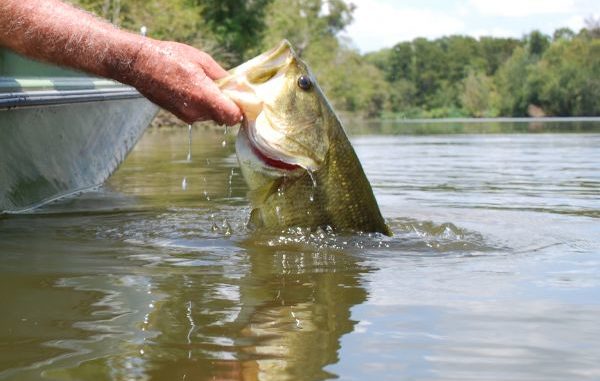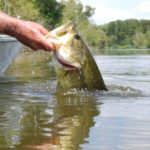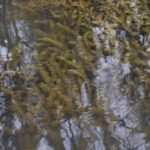
Vegetation control needed to maximize fishery
Bass anglers have a love-hate relationship with submerged plants. Called submerged aquatic vegetation (SAV) by biologists, they are a constant factor in freshwater fishing in Louisiana.
Some, such as hydrilla and Eurasian water milfoil, are non-native exotics. Others, including coontail, water primrose, pondweeds and wigeon grass are native. All thrive in Louisiana’s near-tropical weather.
Fishing can be fabulous in or near weed beds, but it can also be impossible because growths can be so dense that neither boat nor hook can penetrate them. The amount and kinds of these plants can affect spawning, survival and growth of bass.
A few years ago, Florida Game and Fresh Water Fish Commission biologists conducted a study of 10 lakes to determine whether bass food habits and growth rates were different in lakes with heavy growths of SAVs as compared to lakes with very little plant life. Four lakes in the study had at least 40 percent of their total area grown up with water plants, mostly hydrilla; four lakes had almost no SAVs because of control by grass carp; and two others had fluctuating levels of plant life during the study.
A total of 5,818 largemouth bass were collected from the lakes using electrical shocking equipment. The bass were measured, aged by counting the growth rings in their otoliths (ear bones) and had their stomach contents analyzed. Some of the results were very interesting:
• Bass from heavily vegetated lakes fed on more different species of fish than those from unvegetated lakes.
• In smaller bass, 1 ½ to 6 inches, 43 percent from vegetated lakes had empty stomachs as compared to 23 percent from unvegetated lakes.
• Bass from unvegetated lakes fed on very different food items than those from vegetated lakes until they reached 14 inches long. After that size, bass from both types of lakes fed on the same foods.
• Bass shifted their diet from insects and other small animals to fish at a much smaller size (2 ½ inches) in unvegetated lakes than those in vegetated lakes (5 inches).
• The earlier shift resulted in bass from unvegetated lakes growing faster than those from vegetated lakes for the first 3 or 4 years of life. This may be partially explained by the fact that bass in unvegetated lakes fed more heavily on shad than those from vegetated lakes. Previous research has shown that shad are a superior food fish species.
• Populations of bass in unvegetated lakes are not as heavy as in vegetated lakes.
The biologists concluded that management of SAVs to reduce them at some times of the year and to allow strong growth at other times can increase survival of largemouth bass spawns, increase growth rates and improve bass catch rates.
One method of SAV management is the drawdown — simply lowering the water level of a lake to a level that is lower than what is “normal.” Drawdowns can not only be used to kill or set back SAV growth, but they can improve fishing when a lake has too many forage or food fish or a large population of stunted bluegills.
A drawdown will force the small fish out of the vegetation and concentrate them where bass and other predator fish can more easily feed on them and control their numbers.
Drawdowns are a most effective tool at controlling hydrilla. When done in the summer, the drawdown disrupts the plant’s ability to form underground tubers from which new plants sprout. In Louisiana, summer drawdowns typically begin in early July and extend into November. Fall/winter drawdowns are also conducted in Louisiana.
Lake drawdowns are also used by biologists for other purposes.
Lakes, especially backwater lakes that have been flooded for a long time, often accumulate a layer of muck on the bottom. Nest-spawning fish such as bass and bluegill have very poor nesting success on these soft bottoms.
These fish search for firm bottom on which to construct their nests. A good indicator of poor spawning bottoms in a lake is when bass and bluegill nest on top of stumps and logs because they can’t find firm bottom elsewhere.
A drawdown exposes these soft bottoms to air, which allows the organic muck to decay and break down. It also allows the inorganic silts to consolidate and become firmer. Often several drawdowns over several years are needed to get the job done.
Without a drawdown, spawning success can become erratic and successful only in years when high rainfall causes lake waters to flood areas not normally underwater. The newly flooded, muckless bottoms are much firmer and suitable for nest construction.
For the same reason, spring river floods can play an important part in determining the strength of a year class for bass. Simply put, years with strong floods produce more fish from the spawn than do years of no or weak flooding.
A study done by Illinois fisheries biologists in the early 1990s in the Illinois River illustrates the point perfectly. In the years of high spring floods (1990, 1993 and 1995) young-of-the-year bass made up 20 percent of samples they made with shocking machines. The strong year-classes continued to show up in high numbers the following years.
In years of low spring floods (1991, 1992 and 1994) young-of-the-year bass made up only 7 percent of the total bass numbers.




